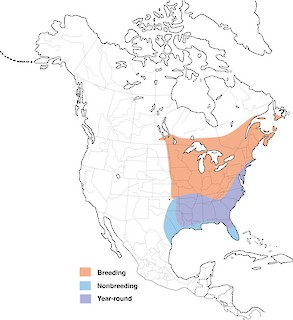American WoodcockScolopax minorScientific name definitions
- LCLeast Concern
- Names(36)
- Monotypic
Text last updated July 26, 2013
Sign in to see your badges

Sign in to see your badges
| Language | Common name |
|---|---|
| Afrikaans | Amerikaanse Woudsnip |
| Azerbaijani | Kiçik meşə çilingdimdiyi |
| Basque | Oilagor amerikarra |
| Bulgarian | Американски бекас |
| Catalan | becada americana |
| Croatian | američka šljuka |
| Czech | sluka americká |
| Danish | Amerikansk Skovsneppe |
| Dutch | Amerikaanse houtsnip |
| English | American Woodcock |
| English (AVI) | American Woodcock |
| English (United States) | American Woodcock |
| Estonian | ameerika kurvits |
| Finnish | amerikanlehtokurppa |
| French | Bécasse d'Amérique |
| German | Kanadaschnepfe |
| Greek | Αμερικανική Μπεκάτσα |
| Hungarian | Koboldszalonka |
| Icelandic | Kjarrsnípa |
| Japanese | アメリカヤマシギ |
| Latvian | Amerikas sloka |
| Lithuanian | Amerikinė slanka |
| Norwegian | amerikarugde |
| Polish | słonka amerykańska |
| Portuguese (Portugal) | Galinhola americana |
| Romanian | Sitar de pădure american |
| Russian | Американский вальдшнеп |
| Serbian | Američka šumska šljuka |
| Slovak | sluka svišťavá |
| Slovenian | Ameriška sloka |
| Spanish | Chocha Americana |
| Spanish (Mexico) | Chocha del Este |
| Spanish (Spain) | Chocha americana |
| Swedish | amerikansk morkulla |
| Turkish | Küçük Çulluk |
| Ukrainian | Слуква американська |
Full content is available exclusively to Birds of the World subscribers.Sign inLearn more
Birds of the World is an open-access scientific resource in {0}. Sign in or create a Cornell Lab account to enter.
This species account is dedicated in honor of Perk (Leigh) Perkins, member of the Cornell Lab of Ornithology's Administrative Board.
Perhaps because of its bizarre looks and unique behaviors, the American Woodcock has gained ardent and appreciative followers among North America's hunters and birdwatchers. Writing of this plump, compact little shorebird's memorable spring courtship flights, in which males spiral up high on twittering wings with melodious chirping and then circle back sharply to the ground to resume their unique peenting display, the conservationist Aldo Leopold (1949) concluded that such dawn and dusk “sky dances” are a living "refutation of the theory that the utility of a game bird is to serve as a target, or to pose gracefully on a slice of toast.”
Several features help to distinguish this forest-dwelling shorebird from its more aquatic relatives (Scolopacidae): a long bill specialized for feeding on earthworms, a stout head with large eyes set far back for rearview binocular vision, a polygynous mating system, sexes monomorphic in color with females substantially larger than males, and plumage with mottled, leaf-brown patterns that blend superbly with the forest floor. Indeed, the body and behavior of this woodcock have given it many colorful vernacular names such as timberdoodle, Labrador twister, night partridge, and bog sucker.
Widely distributed in eastern North America, woodcock are migratory, nesting in young forests and old fields northward to southern Canada, as well as on their winter range in southern states. Courtship displays and nesting span a six month period beginning in mid-winter in the south and extending into June in the north. Across its northern range, woodcock appear to be the earliest migrant species to breed.
The popularity of this game bird is reflected by a rich history of its market and sport hunting, and by an extensive literature on its biology and management. Today, hunting popularity has dropped since the 1970s when roughly two million American Woodcock were shot annually by about 700,000 hunters. Currently (2012) about 350,000 woodcock are harvested annually by about 160,000 hunters (Gendron and Collins 2007, Raftovich et al. 2012).
Although its abundance has declined in recent years, particularly in its eastern range and probably owing to natural succession and forestry practices, there is no evidence that its overall range has shrunk. Further decline in numbers of this woodcock may result if forest management increasingly favors older, uneven-aged stands, which do not provide suitably large areas of shrubland and young forest that this species needs to breed successfully. Yet this bird's extensive use of northern coniferous forests that are being opened up by large-scale harvesting is encouraging, and suggests that the species may be extending its distribution northward and westward.

Breeding and nonbreeding distribution of the American Woodcock. See text for details.

A global alliance of nature organizations working to document the natural history of all bird species at an unprecedented scale.